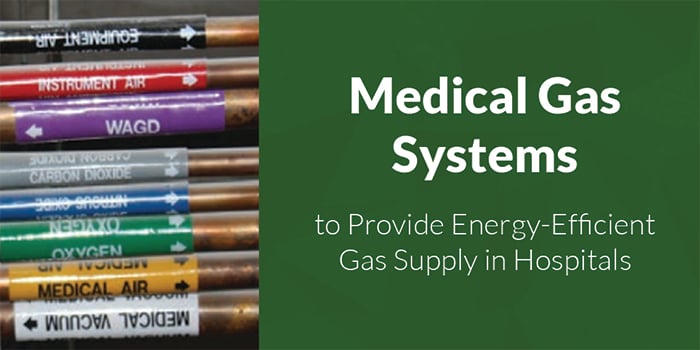
Cutting energy costs and reducing energy consumption are some of the first places healthcare facilities pursue to reduce their environmental impact and enhance sustainability. Healthcare organizations spend over $8 billion on energy each year, and that amount is rising to meet patients' needs.
By increasing energy efficiency, hospitals can improve their bottom line, freeing up funds to invest in new technologies and improve patient care.
As healthcare facility managers, you understand that medical gases and vacuum systems provide a safe and cost-effective source of the medical gases you require. Sources that produce the flow of medical gases through the piping networks are essential. This article looks at some of the energy-efficient central supply sources in healthcare facilities.

According to Healthcare Design Magazine, lighting, ventilation, water heating, space heating, and space cooling are the top five energy use areas in hospitals. And while looking at these areas and seeing where you can save energy is critical, we want to look deeper into your medical gas system components.
Reducing energy use requires planning and benchmarking your facility's overall energy performance. As in the pumps, compressors, manifolds, and bulk containers, source equipment provides or creates medical gases in the hospital piping system. Source equipment may have multiple hardware pieces to filter, pressurize, and clean to provide a safe medical gas.
No individual healthcare facility can usually adopt all of the energy-efficient strategies and practices to reduce power consumption due to cost.
However,
A few strategies can be put in place today or planned for in the future. Facilities can find energy savings through multiple efforts.
Gas Supply Parts for Oxygen, Nitrous Oxide, and Carbon Dioxide
Common gases used in healthcare include oxygen, nitrous oxide, nitrogen, carbon dioxide, and medical air. The gases are delivered from their central supply source through a piping network.
Some gases may be supplied either in cylinders or via pipeline. The cylinders were traditionally constructed of low-carbon steel. Today, they are constructed of lightweight chrome-molybdenum steel, aluminum, or a composite (such as aluminum wrapped in carbon fiber), making them more energy-efficient.
Central Supply Sources for Air and Vacuum
A reduction of energy costs at your central supply systems can be achieved through various methods. For medical-surgical vacuum systems, a variable frequency drive (VFD) installed on a rotary claw system can provide a return on your investment in just a couple of years and save tens of thousands of dollars in energy savings over the lifespan of the unit. For some existing claw units, a new control cabinet outfitted with a VFD can be installed to achieve similar results.
For medical air systems, upgrading your entire system or even your dryer package can also reduce energy consumption. Although few are still in use, it is not uncommon for older facilities to still be employing refrigerant dryer systems on their medical air. Upgrading to desiccant dryers can dramatically improve the efficiency and performance of your existing medical air systems.
It’s also important to provide proper maintenance on your pumps and compressors to inspect and replace any filters, belts, and oil according to the manufacturer’s recommendations or as determined by your facility’s Alternative Equipment Maintenance (AEM) program. This will ensure your systems continue to operate as designed.
And for those facilities still utilizing liquid ring medical air or vacuum systems, a complete replacement with a scroll compressor or claw vacuum system is highly recommended. In addition to the electrical savings, a significant reduction in water costs can also be achieved.
Control and Valve Boxes for Security
Healthcare personnel must ensure all equipment is functioning as specified and appropriately designed.
A zone valve controls every medical gas outlet. While zone valves are sometimes overlooked as a static component, your medical gas system's safe and effective operation requires ongoing attention and inspection of these assets to continually assess any apparent risk.
The valve boxes' primary purpose is to provide fast access to the medical gas pipeline distribution system if there is an emergency. Emergency shut-off valves, or zone valves, are often installed to stop gas from flowing into an area during servicing or in the event of a fire or substantial leak. Valves may be positioned at department entrances, with emergency pull-out windows provided for access.
Medical Gas Terminal Units
Terminal units are the points on a medical gas pipeline system where the operator makes connections and disconnections for gas supply. A wrong connection could result in a hazard to a patient or the operator.
Medical gas station inlets and outlets are tested for flow and leakages. Even relatively small leaks, if left unaddressed, can result in excess cost and use of your medical gas supply systems. Additionally, some newer terminal units provide antimicrobial protection for patient safety and improved maintenance (resulting in a more energy-efficient source).
Conclusion
Healthcare systems' challenge is to reduce energy consumption while enhancing patient outcomes and minimizing costs with its medical gas piping.
Medical gas systems must be installed by qualified ASSE 6010 installers and then verified by an ASSE 6030 qualified verifier before they can be used.
For protection and efficiency, once a system is up and running, annual inspections ensure the patients and the staff are protected and served well by the system.




